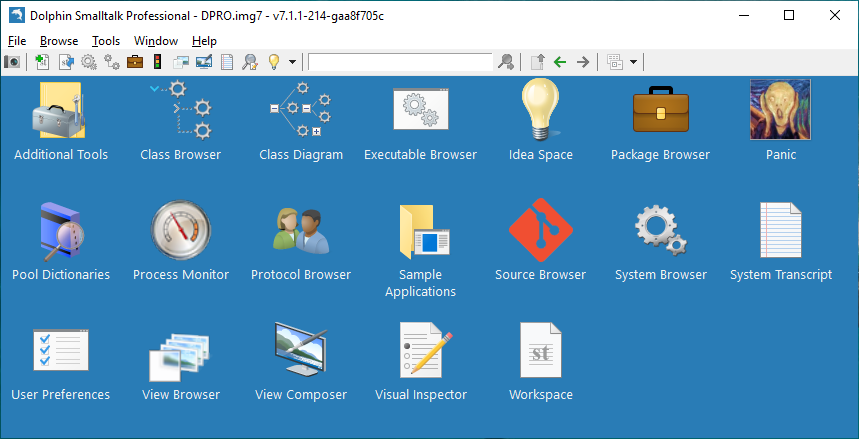This repository contains the necessary files to build the Dolphin Smalltalk Core Images from a pre-built boot image.
Note: if you are just looking to install Dolphin and get going as quickly as possible you may prefer to start with the release build and Setup Installer and follow the directions here. However, if you’d really like to know how Dolphin is put together then the sources are available here on GitHub in two repositories:
-
Dolphin - This repository. This the Dolphin image and the means to build the various product incarnations from a prebuilt boot image. Executables for the various virtual machine components are not included, so it is necessary to either fetch them as binaries from the DolphinVM Releases or to compile them from source. If you really do want to build the VM, you'll want the repo below in addition to this one.
-
DolphinVM - This is repository for the Dolphin Smalltalk virtual machine and the helper DLLs for deploying to the different Windows target formats.
Follow these instructions to create the product images and launch Dolphin Smalltalk for the first time.
-
First clone the Dolphin repository (this one) into a suitable working directory on your machine, let's call it
\Dolphin. Any version of Windows from Vista onwards should be suitable but most validation has been done under Windows 10. -
Next you will need to build or fetch the VM binaries. For convenience a batch file,
FetchVM.CMDis supplied and, providing you have PowerShell scripting enabled, you can just double-click this to pull the correct version of the VM down from GitHub. Alternatively, you can right click on theFetchVM.ps1file and choose Run with PowerShell, which does not require scripting to be explicitly enabled in Windows. If you supply a parameter to either of these script files you can choose to fetch an alternative VM version to the default (not usually recommended). Remember, you can also choose to build the VM from source if you wish. -
In the same directory you will find a number of CMD files used boot the images for the various products. Two such products are available, DCORE and DPRO. Normally, you will want to use DPRO only, since this is a superset of DCORE. However, it is worthwhile booting both products after each change to make sure that nothing in the boot sequence has been broken. This can be done with the
BootAllCMD file. Note: DPRO stands for Dolphin Professional. -
Double-click
BootAll.cmd. A console window will open and sequentially spawn the individual boot jobs. Depending on the heritage of your Windows environment, you may see a failure message saying thatMSVCRT140.DLLcannot be found. If this is the case on your system, you will need to download and install the Microsoft Visual C++ 2015 Redistributable components. Since Dolphin is a 32 bit application you’ll only needvcredist_x86.exe. If you need to do this then, once installed, try theBootAllagain. -
When the boot processes have completed, you should see a number of
.img7files in your directory. IMG7 is the new image extension for Dolphin 7. You should right click onDPRO.img7and choose Open With, selectingDolphin7.exeas the executable to be permanently associated with this file type.
You should see Dolphin Professional 7 launch successfully. We’ll leave it as an exercise for the reader to work out how to dismiss the splash screen. You can now continue with the Dolphin Getting Started introduction if you wish.
